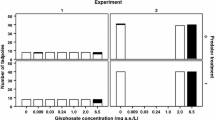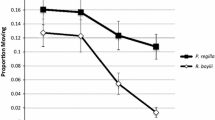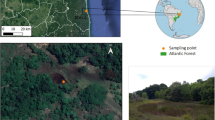Abstract
The decline in amphibians across the globe has sparked a search for the causes, and recent evidence suggests a connection with pesticides. However, for most pesticides, tests on amphibians are rare and conducted only for short durations (1 to 4 days) and without natural stressors. Recent studies have discovered that the stress of predator cues in the water can make insecticides much more lethal to larval amphibians, but it is unknown whether this phenomenon can be generalized to other types of pesticides. Using six species of North American amphibian larvae (Rana sylvatica, R. pipiens, R. clamitans, R. catesbeiana, Bufo americanus, and Hyla versicolor), I examined the impact of a globally common herbicide (Roundup) on the survival of tadpoles for 16 days with and without the chemical cues emitted by predatory newts (Notophthalmus viridescens). LC5016-d estimates varied from 0.55 to 2.52 mg of active ingredient (AI)/L, which was considerably lower than the few previous studies using Roundup (1.5 to 15.5 mg AI/L). Moreover, in one of the six species tested (R. sylvatica), the addition of predatory stress made Roundup twice as lethal. This discovery suggests that synergistic interactions between predatory stress and pesticides may indeed be a generalizable phenomenon in amphibians that occurs with a wide variety of pesticides.


Similar content being viewed by others
References
RA Alford SJ Richards (1999) ArticleTitleGlobal amphibian declines: A problem in applied ecology Annu Rev Ecol Syst 30 133–165 Occurrence Handle10.1146/annurev.ecolsys.30.1.133
Aspelin AL, Grube AH (1999) Pesticide industry sales and usage: 1996 and 1997 market estimates (publication no. 733-R-99-001). Office of Pesticide Programs, U.S. Environmental Protection Agency.
InstitutionalAuthorNameAmerican Society for Testing and Materials (1996) Annual book of ASTM standards American Society for Testing and Materials Philadelphia, PA
L Berger R Speare P Daszak DE Green AA Cunningham (1998) ArticleTitleChytridiomycosis causes amphibian mortality associated with population declines in the rain forests of Australia and Central America Proc Natl Acad Sci U S A 95 9031–9036 Occurrence Handle10.1073/pnas.95.15.9031 Occurrence Handle1:CAS:528:DyaK1cXkvFaltbc%3D Occurrence Handle9671799
CA Bishop NA Mahony J Struger P Ng KE Pettit (1999) ArticleTitleAnuran development, density and diversity in relation to agricultural activity in the Holland River watershed, Ontario, Canada (1990–1992) Environ Monit Assess 57 21–43 Occurrence Handle10.1023/A:1005988611661 Occurrence Handle1:CAS:528:DyaK1MXltVShu7c%3D
AR Blaustein JM Kiesecker (2002) ArticleTitleComplexity in conservation: Lessons from the global decline of amphibian populations Ecol Lett 5 597–608 Occurrence Handle10.1046/j.1461-0248.2002.00352.x
AR Blaustein DB Wake WP Sousa (1994) ArticleTitleAmphibian declines: Judging stability, persistence, and susceptibility of populations to local and global extinctions Conserv Biol 8 60–71 Occurrence Handle10.1046/j.1523-1739.1994.08010060.x
MD Boone RD Semlitsch (2001) ArticleTitleInteractions of an insecticide with larval density and predation in experimental amphibian communities Conserv Biol 15 228–238 Occurrence Handle10.1046/j.1523-1739.2001.99475.x
MD Boone RD Semlitsch (2002) ArticleTitleInteractions of an insecticide with competition and pond drying in amphibian communities Ecol Appl 12 307–316
MD Boone CM Bridges (1999) ArticleTitleThe effect of temperature on the potency of carbaryl for survival of tadpoles of the green frog (Rana clamitans) Environ Toxicol Chem 18 1482–1484 Occurrence Handle10.1897/1551-5028(1999)018<1482:TEOTOT>2.3.CO;2 Occurrence Handle1:CAS:528:DyaK1MXktVequ7o%3D
JD Cooney (1995) Freshwater tests GM Rand (Eds) Fundamentals of aquatic toxicology Taylor and Francis London, United Kingdom 71–102
C Davidson HB Shaffer MR Jennings (2002) ArticleTitleSpatial tests of the pesticide drift, habitat destruction, UV-B, and climate-change hypotheses for California amphibian declines Conserv Biol 16 1588–1601 Occurrence Handle10.1046/j.1523-1739.2002.01030.x
AN Edginton PM Sheridan GR Stephenson DG Thompson HJ Boermans (2004) ArticleTitleComparative effects of pH and Vision® herbicide on two life stages of four anuran amphibian species Environ Toxicol Chem 23 815–822 Occurrence Handle1:CAS:528:DC%2BD2cXis1KgsLs%3D Occurrence Handle15095875
JC Feng DG Thompson PE Reynolds (1990) ArticleTitleFate of glyphosate in a Canadian forest watershed. 1. Aquatic residues and off-target deposit assessment J Agric Food Chem 38 1110–1118 Occurrence Handle1:CAS:528:DyaK3cXhsleqtLo%3D
RN Fisher HB Shaffer (1996) ArticleTitleThe decline of amphibians in California’s Great Central Valley Conserv Biol 10 1387–1397
JP Giesy S Dobson KR Solomon (2000) ArticleTitleEcotoxicological risk assessment for Roundup herbicide Rev Contam Toxicol 167 35–120 Occurrence Handle1:CAS:528:DC%2BD3cXntVyls74%3D
LG Goldsborough DJ Brown (1989) ArticleTitleRapid dissipation of glyphosate and aminomethylphosphonic acid in water and sediments of boreal forest ponds Environ Toxicol Chem 12 1139–1147
KL Gosner (1960) ArticleTitleA simplified table for staging anuran embryos and larvae with notes on identification Herpetologica 16 183–190
TB Hayes A Collins M Lee M Mendoza N Noriega AA Stuart et al. (2002) ArticleTitleHermaphroditic, demasculinized frogs after exposure to the herbicide atrazine at low ecologically relevant doses Proc Natl Acad Sci USA 99 5476–5480 Occurrence Handle1:CAS:528:DC%2BD38XjtFKlsbc%3D Occurrence Handle11960004
LM Horner (1990) Dissipation of glyphosate and aminomethylphosphonic acid in forestry sites. Unpublished report MSL-9940 Monsanto Company St. Louis, MO
JE Houlihan CS Findlay BR Schmidt AH Meyers SL Kuzmin (2001) ArticleTitleQuantitative evidence for global amphibian population declines Nature 404 752–755
LB Kats LM Dill (1998) ArticleTitleThe scent of death: Chemosensory assessment of predation risk by prey animals Ecoscience 5 361–394
JM Kiesecker AR Blaustein LK Belden (2001) ArticleTitleComplex causes of amphibian population declines Nature 410 681–684 Occurrence Handle1:STN:280:DC%2BD3M3gtVOhsA%3D%3D Occurrence Handle11287952
RC Lajmanovich MT Sandoval PM Peltzer (2003) ArticleTitleInduction of mortality and malformation in Scinax nasicus tadpoles exposed to glyphosate formulations Bull Environ Contam Toxicol 70 612–618 Occurrence Handle1:CAS:528:DC%2BD3sXitFGmtrc%3D Occurrence Handle12592539
JS LeNoir LL McConnell GM Fellers TM Cahill JN Seiber (1999) ArticleTitleSummertime transport of current-use pesticides from California’s central valley to the Sierra Nevada Mountain range, USA Environ Toxicol Chem 18 2715–2722 Occurrence Handle1:CAS:528:DyaK1MXns1GlsLY%3D
TW Lohner SW Fisher (1990) ArticleTitleEffects of pH and temperature on the acute toxicity and uptake of carbaryl in the midge, Chironomus riparius Aquat Toxicol 16 335–354 Occurrence Handle1:CAS:528:DyaK3cXksFCjsrs%3D
RM Mann JR Bidwell (1999) ArticleTitleThe toxicity of glyphosate and several glyphosate formulations to four species of southwestern Australian frogs Arch Environ Contam Toxicol 26 193–199
M Newton KM Howard BR Kelpsas R Danhaus CM Lottman S Dubelman (1984) ArticleTitleFate of glyphosate in an Oregon forest ecosystem J Agric Food Chem 32 1144–1151 Occurrence Handle1:CAS:528:DyaL2cXlt1CntLY%3D
JHK Pechmann DE Scott RD Semlitsch JP Caldwell LJ Vitt JW Gibbons (1991) ArticleTitleDeclining amphibian populations: The problem of separating human impacts from natural fluctuations Science 253 892–895
JHK Pechmann HM Wilbur (1994) ArticleTitlePutting declining amphibian populations in perspective: Natural fluctuations and human impacts Herpetologica 50 65–84
PJ Perkins HJ Boermans GR Stephenson (2000) ArticleTitleToxicity of glyphosate and triclopyr using the frog embryo teratogenesis assay-Xenopus Environ Toxicol Chem 19 940–945 Occurrence Handle1:CAS:528:DC%2BD3cXitFejurg%3D
RA Relyea (2001) ArticleTitleMorphological and behavioral plasticity of larval anurans in response to different predators Ecology 82 523–540
RA Relyea (2003) ArticleTitlePredator cues and pesticides: A double dose of danger for amphibians Ecol Appl 13 1515–1521
RA Relyea (2004a) ArticleTitleSynergistic impacts of malathion and predatory stress on six species of North American tadpoles Environ Toxicol Chem 23 1080–1084 Occurrence Handle1:CAS:528:DC%2BD2cXis1Kgt7Y%3D
RA Relyea (2004b) ArticleTitleThe growth and survival of five amphibian species exposed to combinations of pesticides Environ Toxicol Chem 23 1080–1084 Occurrence Handle1:CAS:528:DC%2BD2cXis1Kgt7Y%3D
RA Relyea N Mills (2001) ArticleTitlePredator-induced stress makes the pesticide carbaryl more deadly to grey treefrog tadpoles (Hyla versicolor) Proc Nat Acad Sci USA 98 2491–2496 Occurrence Handle1:CAS:528:DC%2BD3MXhslKmsrY%3D Occurrence Handle11226266
DK Skelly KL Yurewicz EE Werner RA Relyea (2003) ArticleTitleQuantifying decline and distributional change in amphibians Conserv Biol 17 744–751
GR Smith (2001) ArticleTitleEffects of acute exposure to a commercial formulation of glyphosate on the tadpoles of two species of anurans Bull Contam Toxicol 67 483–488 Occurrence Handle1:CAS:528:DC%2BD3MXnslCqtL4%3D
DW Sparling GM Fellers LS McConnell (2001) ArticleTitlePesticides and amphibian population declines in California, USA Environ Toxicol Chem 20 1591–1595 Occurrence Handle1:CAS:528:DC%2BD3MXks1Gltb4%3D Occurrence Handle11434303
DG Thompson BF Wojtaszek B Staznik DT Chartrand GR Stephenson (2004) ArticleTitleChemical and biomonitoring to assess potential acute effects of Vision® herbicide on native amphibian larvae in forest wetlands Environ Toxicol Chem 23 843–849 Occurrence Handle1:CAS:528:DC%2BD2cXis1KgsLY%3D Occurrence Handle15095878
MT Tsui LM Chu (2003) ArticleTitleAquatic toxicity of glyphosate-based formulations: Comparison between different organisms and the effects of environmental factors Chemosphere 52 1189–1197 Occurrence Handle1:CAS:528:DC%2BD3sXkvVCitLY%3D Occurrence Handle12821000
InstitutionalAuthorNameU. S. Environmental Protection Agency, Hazard Evaluation Division (1985a) Standard evaluation procedure: Acute toxicity for freshwater invertebrates (PB86-129269) U. S. Environmental Protection Agency Washington, DC
InstitutionalAuthorNameU. S. Environmental Protection Agency, Hazard Evaluation Division (1985b) Standard evaluation procedure: Acute toxicity for freshwater fish (PB86-129277) U. S. Environmental Protection Agency Washington, DC
U. S. Environmental Protection Agency (1992) Pesticide tolerance for glyphosate. Fed. Reg. 57:8739 40, 10–98
DB Wake (1998) ArticleTitleAction on amphibians Tree 13 379–380
BF Wojtaszek B Staznik DT Chartrand GR Stephenson DG Thompson (2004) ArticleTitleEffects of Vision® herbicide on mortality, avoidance response, and growth of amphibian larvae in two forest wetlands Environ Toxicol Chem 23 832–842 Occurrence Handle1:CAS:528:DC%2BD2cXis1KgsLk%3D Occurrence Handle15095877
A Zaga EE Little CF Raben MR Ellersieck (1998) ArticleTitlePhotoenhanced toxicity of a carbamate insecticide to early life stage anuran amphibians Environ Toxicol Chem 17 2543–255 Occurrence Handle1:CAS:528:DyaK1cXnsFertr4%3D
Acknowledgments
My thanks to Josh Auld, Jason Hoverman, Laura Howell, Adam Marko, Christine Relyea, and Nancy Schoeppner for assisting with the experiments. I thank Josh Auld, Jason Hoverman, April Randle, and Nancy Schoeppner for reviewing the manuscript. This research was supported by the National Science Foundation.
Author information
Authors and Affiliations
Corresponding author
Rights and permissions
About this article
Cite this article
Relyea, R.A. The Lethal Impacts of Roundup and Predatory Stress on Six Species of North American Tadpoles. Arch Environ Contam Toxicol 48, 351–357 (2005). https://doi.org/10.1007/s00244-004-0086-0
Received:
Accepted:
Published:
Issue Date:
DOI: https://doi.org/10.1007/s00244-004-0086-0




